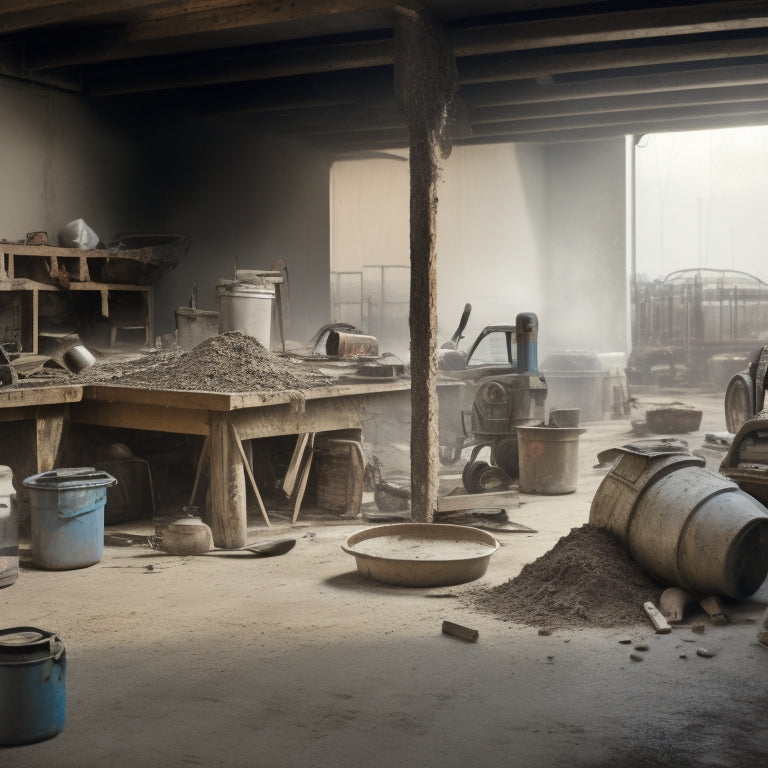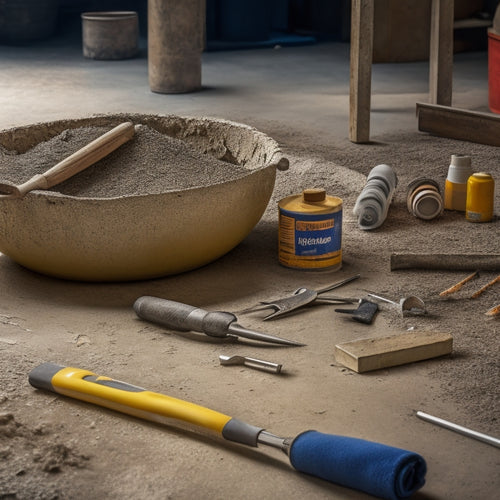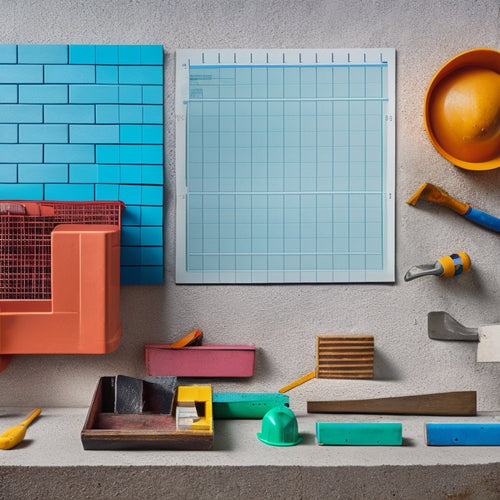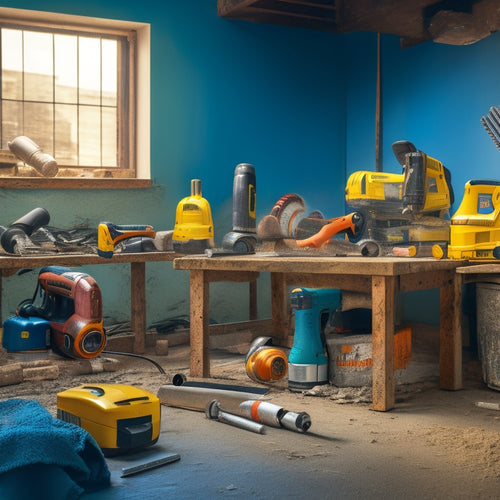
What Tools Do You Need for Concrete Grinding
Share
You'll need a range of specialized tools and equipment to tackle concrete grinding projects efficiently and safely. Start with essential grinding machine types, such as walk-behind, ride-on, and handheld grinders, each designed for specific tasks and surface areas. Diamond tooling and accessories, including blades and grinding pads, are also vital, as well as safety gear like protective gloves, safety goggles, and face masks. Additionally, dust control and ventilation systems, measuring and marking tools, edge working and corner tools, and cleaning and finishing equipment are all essential components of your concrete grinding arsenal. As you assemble your toolkit, you'll be well on your way to achieving professional-grade results.
Key Takeaways
• Essential grinding machine types include walk-behind, ride-on, and handheld grinders, each suited for specific tasks and surface areas.
• Diamond tooling and accessories, such as blades and grinding pads, are critical for task-specific grinding and polishing tasks.
• Safety gear and protective wear, including gloves, goggles, and respirators, are necessary to prevent injury and health risks.
• Dust control and ventilation measures, such as dustless grinding systems and vacuum-equipped grinders, are crucial for maintaining safe air quality.
• Measuring and marking tools, like tape measures and marking chalk, ensure accurate calculations and precise grinding efforts.
Essential Grinding Machine Types
You'll frequently encounter three vital types of grinding machines on a concrete grinding job site: walk-behind, ride-on, and handheld grinders, each designed to tackle specific tasks and surface areas.
Walk-behind grinders are ideal for larger areas, offering high production rates and versatility. They're perfect for grinding and polishing large floors, removing old coatings, and preparing surfaces for new finishes.
Ride-on grinders, on the other hand, are designed for high-production grinding and are often used for large commercial or industrial projects. They offer increased productivity and are typically equipped with advanced features like hydraulic systems and adjustable handlebars.
Handheld grinders are perfect for smaller, hard-to-reach areas, such as stairs, curbs, and edges.
Regardless of the grinding machine type, regular machine maintenance is essential to guarantee peak performance, extend equipment lifespan, and prevent costly repairs.
Diamond Tooling and Accessories
With a concrete grinding machine in hand, it's the diamond tooling and accessories that truly bring the operation to life, providing the cutting power and versatility needed to tackle a wide range of tasks and surface conditions.
You'll need to choose the right diamond blade type for your specific task, as different blades are designed for specific applications, such as coarse grinding, fine grinding, or polishing. For example, a turbo blade is ideal for aggressive grinding, while a segmented blade is better suited for finer grinding.
In addition to diamond blades, you'll also need to select the right grinding pad for your job. Grinding pads come in various grit levels, ranging from coarse to fine, and are designed to work in conjunction with your diamond blade. A coarse grit pad is used for heavy grinding, while a fine grit pad is used for polishing and refining.
Safety Gear and Protective Wear
Operating a concrete grinding machine requires wearing proper safety gear and protective wear to prevent injuries from flying debris, dust, and vibration.
You'll need a pair of protective gloves to shield your hands from cuts and abrasions. Look for gloves with grip palms to prevent slips and falls.
Additionally, safety goggles or glasses with shatter-resistant lenses will protect your eyes from flying particles. A face mask or respirator can also be worn to prevent inhalation of concrete dust.
You'll also need to wear a dust-resistant jacket or coveralls to prevent skin irritation and contamination.
Steel-toed boots or work shoes with a non-slip sole will provide traction and protection for your feet. Don't forget a hard hat or bump cap to protect your head from falling objects or debris.
Finally, consider wearing earplugs or earmuffs to reduce the noise level from the grinding machine.
Dust Control and Ventilation
When you're grinding concrete, you're generating a significant amount of airborne dust that can pose serious health risks and compromise air quality.
To mitigate this, you'll need to implement effective dust control measures, such as using dustless grinding systems or vacuum-equipped grinders that capture particles at the source.
Airborne Dust Prevention
You'll need to implement effective airborne dust prevention measures to minimize the risks associated with concrete grinding, as the process generates a significant amount of respirable dust particles that can pose serious health hazards if not controlled.
To achieve this, you'll need to employ dust suppression techniques that minimize the amount of airborne dust generated during the grinding process. This can be achieved through the use of dust-collecting attachments, such as vacuum dust collectors, which can be attached to your grinder. Additionally, you can use air quality monitoring devices to measure the level of airborne dust particles and adjust your suppression techniques accordingly.
Here are some examples of airborne dust prevention measures you can implement:
| Dust Suppression Technique | Effectiveness | Cost |
|---|---|---|
| Vacuum Dust Collectors | High | Moderate |
| Water Spraying | Medium | Low |
| Dust-Reducing Grinding Discs | Medium | High |
| Respiratory Protection | Low | Low |
| Air Quality Monitoring Devices | High | High |
Proper Ventilation Systems
By incorporating airborne dust prevention measures, you've taken the first step in minimizing health risks, but now it's equally important to establish proper ventilation systems that can effectively capture and remove airborne dust particles from the work area. This is essential because concrete grinding generates a significant amount of dust that can compromise air quality and pose serious health risks if not properly controlled.
The importance of ventilation in concrete grinding can't be overstated. A well-designed ventilation system guarantees that airborne dust particles are captured and removed, maintaining a safe and healthy work environment. This is particularly critical in enclosed spaces where dust can quickly accumulate and become hazardous.
A proper ventilation system consists of a combination of dust extraction units, fans, and ducting that work together to remove dust particles from the air and exhaust them outside.
Measuring and Marking Tools
To guarantee accurate concrete grinding results, you must equip yourself with the right measuring and marking tools, which enable you to precisely assess the concrete's dimensions and identify areas that require attention.
A reliable tape measure is essential for taking precise measurements of the concrete surface, including its length, width, and depth. This allows you to calculate the correct amount of grinding material needed and make sure that you're working within the specified tolerances.
Marking chalk is another vital tool in your measuring and marking arsenal. It enables you to clearly mark areas that require grinding, such as cracks, uneven surfaces, or old coatings. By applying the chalk directly to the concrete, you can create a visual guide that helps you stay focused on the areas that need attention.
This guarantees that you don't miss any spots and that your grinding efforts are concentrated where they're needed most. With the right measuring and marking tools, you'll be able to achieve professional-grade results that meet the highest standards of quality and precision.
Edge Working and Corner Tools
When you're working on edges and corners, you'll need specialized tools to get the job done efficiently.
You'll likely reach for corner grinding attachments, which are designed to fit into tight spaces and grind concrete with precision.
Additionally, edge profiling wheels will help you refine and smooth out edges, ensuring a professional finish.
Corner Grinding Attachments
You'll need corner grinding attachments, also referred to as edge working and corner tools, to effectively smooth and polish concrete surfaces in tight spaces and corners.
These specialized tools are designed to reach areas that traditional grinders can't, allowing you to achieve a uniform finish across the entire surface. Corner grinding attachments typically consist of a flexible shaft with a grinding head or stone attached to the end. This setup enables you to maneuver the tool into tight spaces and corners, making it ideal for corner grinding techniques.
When selecting a corner grinding attachment, consider the type of concrete you're working with and the desired finish. For example, if you're working with rough, uneven concrete, you may need a more aggressive grinding stone.
On the other hand, if you're looking to achieve a high-gloss finish, a finer stone or polishing pad may be necessary.
Edge Profiling Wheels
Edge profiling wheels, a type of edge working and corner tool, step in to tackle the most demanding corner grinding tasks, providing a more aggressive approach to profiling and shaping concrete edges and corners. When you need to remove old coatings, repair damaged corners, or create a smooth finish, edge profiling wheels are the perfect solution. These wheels are designed to withstand the rigors of heavy-duty grinding, allowing you to achieve precise results with ease.
| Edge Profiling Wheel Type | Grit Size | Recommended Use |
|---|---|---|
| Coarse | 16-24 | Aggressive material removal, corner repair |
| Medium | 30-40 | Edge profiling, shape correction |
| Fine | 60-80 | Edge finishing, high-gloss finish |
With edge profiling wheels, you can choose from various grit sizes and types to suit your specific edge profiling techniques and edge finishing options. Whether you're working on a small repair or a large-scale project, these wheels provide the versatility and performance you need to get the job done efficiently. By incorporating edge profiling wheels into your grinding workflow, you'll be able to tackle even the toughest corner grinding tasks with confidence.
Cleaning and Finishing Equipment
Your arsenal of cleaning and finishing equipment should include a range of machines and accessories specifically designed to remove dirt, dust, and other contaminants from the concrete surface. This is essential for ensuring a high-quality finish and preventing defects in the grinding process.
You'll need a variety of cleaning solutions, such as degreasers and etching solutions, to effectively remove oils, dirt, and other substances that can affect the bonding process. In addition, you'll require finishing techniques like scrubbers, brooms, and mops to remove dirt and dust from the surface.
For a more thorough cleaning, consider investing in a ride-on or walk-behind auto scrubber, which can efficiently remove dirt and debris from large areas. You may also need dust collection systems, such as vacuum cleaners or dust extractors, to minimize airborne particles and keep the workspace clean.
Moreover, finishing tools like trowels, floats, and edgers will help you achieve a smooth, even finish. By having the right cleaning and finishing equipment, you'll be able to achieve a professional-grade finish that meets your clients' expectations.
Frequently Asked Questions
Can I Grind Concrete in Freezing Temperatures?
You shouldn't grind concrete in freezing temperatures, as water within the concrete can freeze, causing freeze damage; the temperature impact can lead to reduced grinding efficiency and potentially damage your equipment.
How Do I Prevent Overheating During the Grinding Process?
To prevent overheating during grinding, you'll want to employ efficient grinding techniques, such as using the correct grit sequence and maintaining a consistent speed. Additionally, prioritize tool maintenance by regularly inspecting and cleaning your equipment to guarantee peak performance.
Can I Use a Grinder on Freshly Poured Concrete?
"You're trying to tame a wild mustang, but freshly poured concrete is too green to be ridden; wait at least 28 days for it to cure before applying advanced grinding techniques to avoid damaging the surface."
Do I Need to Rent a Grinder or Can I Buy One?
When deciding between renting or buying a grinder, consider the type you need, such as walk-behind or handheld, and weigh the rental costs against the frequency of use and your budget constraints.
How Often Should I Replace My Diamond Grinding Wheels?
Did you know that 70% of grinder users replace their diamond wheels too soon? You'll extend your diamond wheel lifespan with proper grinding wheel maintenance, checking for wear every 10-15 hours, and replacing them when segment loss exceeds 25%.
Conclusion
You've got your tools, now get grinding! With the right equipment, you're ready to tackle any concrete project.
Did you know that the global concrete grinding market is expected to reach $1.5 billion by 2025? That's a lot of grinding!
With the tools outlined in this article, you'll be well-equipped to take on a share of that market.
Now, get out there and start grinding – safely and efficiently!
Related Posts
-

Top Tools for Repairing Cracked Concrete Surfaces
When tackling a cracked concrete surface repair, you'll need the right tools to guarantee a durable fix. Start with e...
-

Reinforcement Tools Checklist for Concrete Block Walls
You'll need a range of reinforcement materials, including horizontal and vertical rebar, fiber mesh, and anchor bolts...
-

Essential Power Tools for Concrete Block Construction
When building with concrete blocks, you'll need a range of power tools to cut, drill, mix, and finish the blocks to g...


